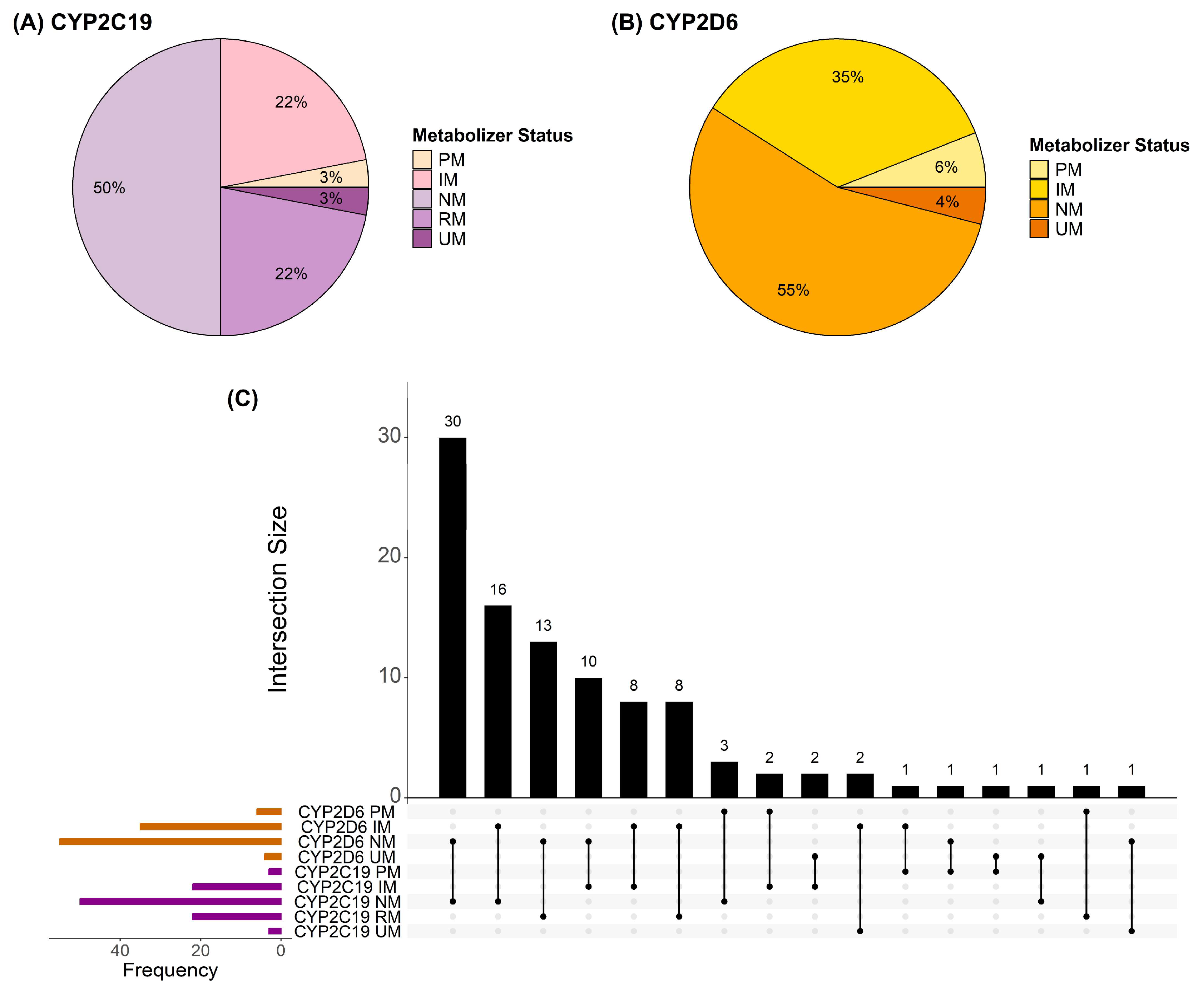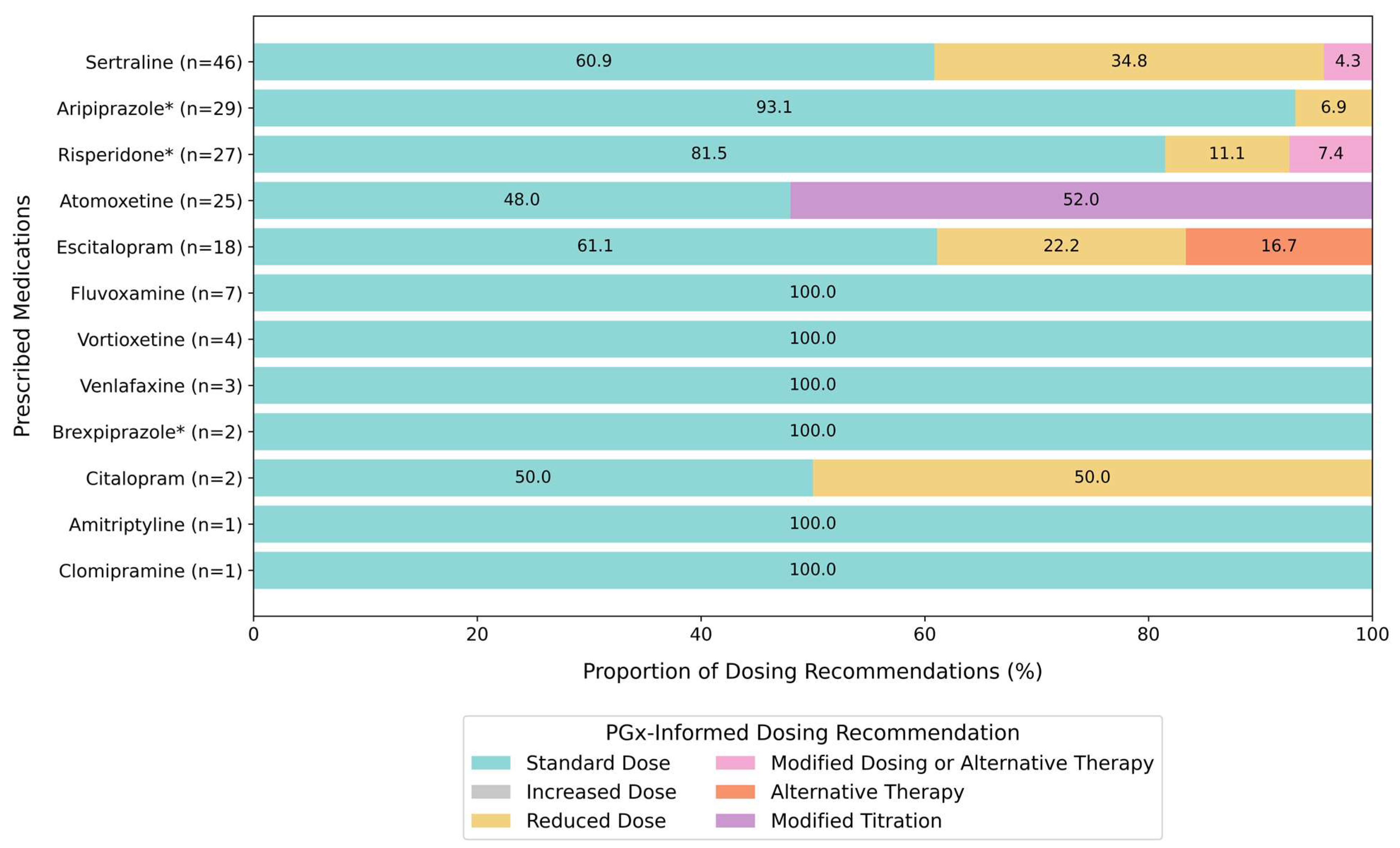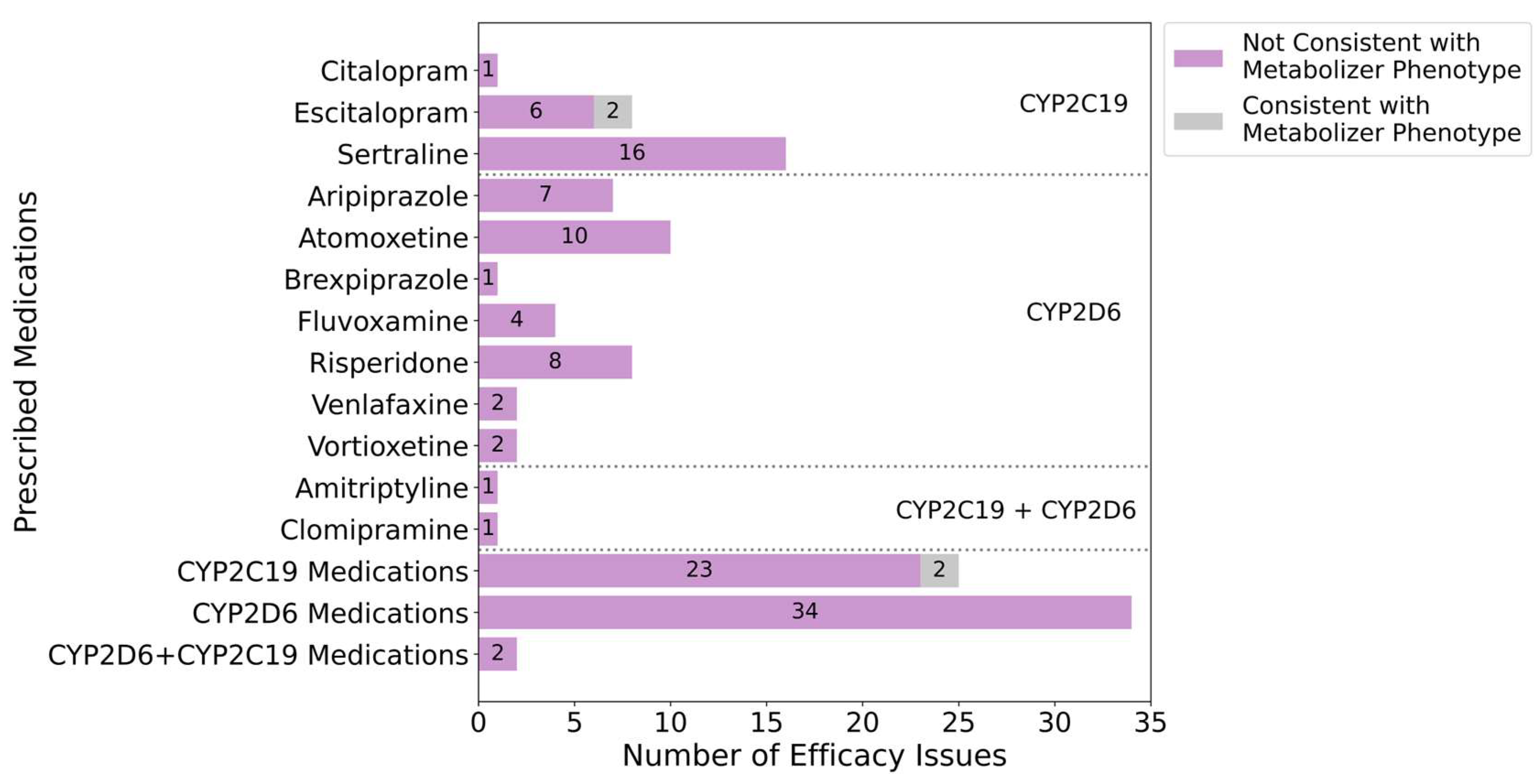Pharmacogenetic Testing of Children and Adolescents with Mental Health Conditions: Real-World Experiences
Abstract
1. Introduction
2. Results
2.1. Cohort Characteristics
2.2. CYP2C19 and CYP2D6 Metabolizer Phenotype Frequencies
2.3. Theoretical Impact on Dosing
2.4. Treatment Response
2.5. Medication-Centered Analysis: Relationship Between PGx Phenotype and ADRs
2.6. Medication-Centered Analysis: Relationship Between PGx Phenotype and Medication Inefficacy
2.7. Participant-Centered Analysis: PGx Testing Utility
3. Discussion
4. Materials and Methods
4.1. Study Cohort
4.2. PGx Analyses
4.3. Evaluation of Treatment Response
4.4. Diplotype to Phenotype Translation: Theoretical Impact on Dosing
4.5. PGx Phenotype and Treatment Response: Medication-Centered Analysis
4.6. PGx Phenotype and Treatment Response: Participant-Centered Analysis
5. Conclusions
Supplementary Materials
Author Contributions
Funding
Institutional Review Board Statement
Informed Consent Statement
Data Availability Statement
Acknowledgments
Conflicts of Interest
Abbreviations
| PGx | Pharmacogenetic |
| ADR | Adverse drug reaction |
| SSRI | Selective serotonin reuptake inhibitor |
| SNRI | Serotonin–Norepinephrine Reuptake Inhibitors |
| CPIC | Clinical Pharmacogenetics Implementation Consortium |
| DPWG | Dutch Pharmacogenetics Working Group |
References
- Chua, K.P.; Volerman, A.; Zhang, J.; Hua, J.; Conti, R.M. Antidepressant Dispensing to US Adolescents and Young Adults: 2016–2022. Pediatrics 2024, 153, e2023064245. [Google Scholar] [CrossRef]
- Antoniou, T.; Pajer, K.; Gardner, W.; Penner, M.; Lunsky, Y.; Tadrous, M.; Mamdani, M.; Gozdyra, P.; Juurlink, D.N.; Gomes, T. Impact of the COVID-19 Pandemic on Antidepressant and Antipsychotic Use among Children and Adolescents: A Population-Based Study. Front. Pediatr. 2023, 11, 1282845. [Google Scholar] [CrossRef] [PubMed]
- Kagan, E.R.; Frank, H.E.; Norris, L.A.; Palitz, S.A.; Chiappini, E.A.; Knepley, M.J.; Crane, M.E.; Phillips, K.E.; Ginsburg, G.S.; Keeton, C.; et al. Antidepressant Use in a 3- to 12-Year Follow-up of Anxious Youth: Results from the CAMELS Trial. Child Psychiatry Hum. Dev. 2021, 52, 41–48. [Google Scholar] [CrossRef]
- Mills, J.A.; Strawn, J.R. Antidepressant Tolerability in Pediatric Anxiety and Obsessive-Compulsive Disorders: A Bayesian Hierarchical Modeling Meta-Analysis. J. Am. Acad. Child Adolesc. Psychiatry 2020, 59, 1240–1251. [Google Scholar] [CrossRef] [PubMed]
- Pozzi, M.; Pisano, S.; Bertella, S.; Capuano, A.; Rizzo, R.; Antoniazzi, S.; Auricchio, F.; Carnovale, C.; Cattaneo, D.; Ferrajolo, C.; et al. Persistence in Therapy With Risperidone and Aripiprazole in Pediatric Outpatients: A 2-Year Naturalistic Comparison. J. Clin. Psychiatry 2016, 77, e1601–e1609. [Google Scholar] [CrossRef]
- Locher, C.; Koechlin, H.; Zion, S.R.; Werner, C.; Pine, D.S.; Kirsch, I.; Kessler, R.C.; Kossowsky, J. Efficacy and Safety of Selective Serotonin Reuptake Inhibitors, Serotonin-Norepinephrine Reuptake Inhibitors, and Placebo for Common Psychiatric Disorders Among Children and Adolescents: A Systematic Review and Meta-Analysis. JAMA Psychiatry 2017, 74, 1011–1020. [Google Scholar] [CrossRef] [PubMed]
- March, J.S.; Silva, S.; Petrycki, S.; Curry, J.; Wells, K.; Fairbank, J.; Burns, B.; Domino, M.; McNulty, S.; Vitiello, B.; et al. The Treatment for Adolescents With Depression Study (TADS): Long-Term Effectiveness and Safety Outcomes. Arch. Gen. Psychiatry 2007, 64, 1132–1143. [Google Scholar] [CrossRef] [PubMed]
- Brent, D.; Emslie, G.; Clarke, G.; Wagner, K.D.; Asarnow, J.R.; Keller, M.; Vitiello, B.; Ritz, L.; Iyengar, S.; Abebe, K.; et al. Switching to Another SSRI or to Venlafaxine with or without Cognitive Behavioral Therapy for Adolescents with SSRI-Resistant Depression: The TORDIA Randomized Controlled Trial. JAMA 2008, 299, 901–913. [Google Scholar] [CrossRef]
- Cheung, A.H.; Zuckerbrot, R.A.; Jensen, P.S.; Laraque, D.; Stein, R.E.K. Guidelines for Adolescent Depression in Primary Care (GLAD-PC): Part II. Treatment and Ongoing Management. Pediatrics 2018, 141, e20174082. [Google Scholar] [CrossRef]
- Egberts, K.M.; Gerlach, M.; Correll, C.U.; Plener, P.L.; Malzahn, U.; Heuschmann, P.; Unterecker, S.; Scherf-Clavel, M.; Rock, H.; Antony, G.; et al. Serious Adverse Drug Reactions in Children and Adolescents Treated On- and Off-Label with Antidepressants and Antipsychotics in Clinical Practice. Pharmacopsychiatry 2022, 55, 255–265. [Google Scholar] [CrossRef] [PubMed]
- Skokou, M.; Karamperis, K.; Koufaki, M.-I.; Tsermpini, E.-E.; Pandi, M.-T.; Siamoglou, S.; Ferentinos, P.; Bartsakoulia, M.; Katsila, T.; Mitropoulou, C.; et al. Clinical Implementation of Preemptive Pharmacogenomics in Psychiatry. EBioMedicine 2024, 101, 105009. [Google Scholar] [CrossRef]
- Bradley, P.; Shiekh, M.; Mehra, V.; Vrbicky, K.; Layle, S.; Olson, M.C.; Maciel, A.; Cullors, A.; Garces, J.A.; Lukowiak, A.A. Improved Efficacy with Targeted Pharmacogenetic-Guided Treatment of Patients with Depression and Anxiety: A Randomized Clinical Trial Demonstrating Clinical Utility. J. Psychiatr. Res. 2018, 96, 100–107. [Google Scholar] [CrossRef]
- Greden, J.F.; Parikh, S.V.; Rothschild, A.J.; Thase, M.E.; Dunlop, B.W.; DeBattista, C.; Conway, C.R.; Forester, B.P.; Mondimore, F.M.; Shelton, R.C.; et al. Impact of Pharmacogenomics on Clinical Outcomes in Major Depressive Disorder in the GUIDED Trial: A Large, Patient- and Rater-Blinded, Randomized, Controlled Study. J. Psychiatr. Res. 2019, 111, 59–67. [Google Scholar] [CrossRef]
- Arnone, D.; Omar, O.; Arora, T.; Östlundh, L.; Ramaraj, R.; Javaid, S.; Govender, R.D.; Ali, B.R.; Patrinos, G.P.; Young, A.H.; et al. Effectiveness of Pharmacogenomic Tests Including CYP2D6 and CYP2C19 Genomic Variants for Guiding the Treatment of Depressive Disorders: Systematic Review and Meta-Analysis of Randomised Controlled Trials. Neurosci. Biobehav. Rev. 2023, 144, 104965. [Google Scholar] [CrossRef]
- Bousman, C.A.; Stevenson, J.M.; Ramsey, L.B.; Sangkuhl, K.; Hicks, J.K.; Strawn, J.R.; Singh, A.B.; Ruaño, G.; Mueller, D.J.; Tsermpini, E.E.; et al. Clinical Pharmacogenetics Implementation Consortium (CPIC) Guideline for CYP2D6, CYP2C19, CYP2B6, SLC6A4, and HTR2A Genotypes and Serotonin Reuptake Inhibitor Antidepressants. Clin. Pharmacol. Ther. 2023, 114, 51–68. [Google Scholar] [CrossRef]
- Beunk, L.; Nijenhuis, M.; Soree, B.; de Boer-Veger, N.J.; Buunk, A.-M.; Guchelaar, H.J.; Houwink, E.J.F.; Risselada, A.; Rongen, G.A.P.J.M.; van Schaik, R.H.N.; et al. Dutch Pharmacogenetics Working Group (DPWG) Guideline for the Gene-Drug Interaction between CYP2D6, CYP3A4 and CYP1A2 and Antipsychotics. Eur. J. Hum. Genet. 2024, 32, 278–285. [Google Scholar] [CrossRef] [PubMed]
- Hicks, J.K.; Sangkuhl, K.; Swen, J.J.; Ellingrod, V.L.; Müller, D.J.; Shimoda, K.; Bishop, J.R.; Kharasch, E.D.; Skaar, T.C.; Gaedigk, A.; et al. Clinical Pharmacogenetics Implementation Consortium Guideline (CPIC) for CYP2D6 and CYP2C19 Genotypes and Dosing of Tricyclic Antidepressants: 2016 Update. Clin. Pharmacol. Ther. 2017, 102, 37–44. [Google Scholar] [CrossRef]
- Brown, J.T.; Bishop, J.R.; Sangkuhl, K.; Nurmi, E.L.; Mueller, D.J.; Dinh, J.C.; Gaedigk, A.; Klein, T.E.; Caudle, K.E.; McCracken, J.T.; et al. Clinical Pharmacogenetics Implementation Consortium Guideline for Cytochrome P450 (CYP)2D6 Genotype and Atomoxetine Therapy. Clin. Pharmacol. Ther. 2019, 106, 94–102. [Google Scholar] [CrossRef] [PubMed]
- Saadullah Khani, N.; Hudson, G.; Mills, G.; Ramesh, S.; Varney, L.; Cotic, M.; Abidoph, R.; Richards-Belle, A.; Carrascal-Laso, L.; Franco-Martin, M.; et al. A Systematic Review of Pharmacogenetic Testing to Guide Antipsychotic Treatment. Nat. Ment. Health 2024, 2, 616–626. [Google Scholar] [CrossRef]
- Namerow, L.B.; Walker, S.A.; Loftus, M.; Bishop, J.R.; Ruaño, G.; Malik, S. Pharmacogenomics: An Update for Child and Adolescent Psychiatry. Curr. Psychiatry Rep. 2020, 22, 26. [Google Scholar] [CrossRef]
- Milosavljević, F.; Molden, P.E.; Ingelman-Sundberg, P.M.; Jukić, A.P.M.M. Current Level of Evidence for Improvement of Antidepressant Efficacy and Tolerability by Pharmacogenomic-Guided Treatment: A Systematic Review and Meta-Analysis of Randomized Controlled Clinical Trials. Eur. Neuropsychopharmacol. 2024, 81, 43–52. [Google Scholar] [CrossRef] [PubMed]
- Santenna, C.; Shubham, A.; Ratinder, J.; Abhijit, R.; Tamonud, M.; Jitendra, S.; Shamim, M.A.; Balakrishnan, S. Drug Metabolizing Enzymes Pharmacogenetic Variation-Informed Antidepressant Therapy Approach for Common Mental Disorders: A Systematic Review and Meta-Analysis. J. Affect. Disord. 2024, 367, 832–844. [Google Scholar] [CrossRef] [PubMed]
- Ramsey, L.B.; Prows, C.A.; Zhang, K.; Saldaña, S.N.; Sorter, M.T.; Pestian, J.P.; Wenstrup, R.J.; Vinks, A.A.; Glauser, T.A. Implementation of Pharmacogenetics at Cincinnati Children’s Hospital Medical Center: Lessons Learned Over 14 Years of Personalizing Medicine. Clin. Pharmacol. Ther. 2018, 105, 49–52. [Google Scholar] [CrossRef]
- Hoffman, J.M.; Haidar, C.E.; Wilkinson, M.R.; Crews, K.R.; Baker, D.K.; Kornegay, N.M.; Yang, W.; Pui, C.-H.; Reiss, U.M.; Gaur, A.H.; et al. PG4KDS: A Model for the Clinical Implementation of Pre-Emptive Pharmacogenetics. Am. J. Med. Genet. C. Semin. Med. Genet. 2014, 166, 45–55. [Google Scholar] [CrossRef]
- Bielinski, S.J.; Olson, J.E.; Pathak, J.; Weinshilboum, R.M.; Wang, L.; Lyke, K.J.; Ryu, E.; Targonski, P.V.; Van Norstrand, M.D.; Hathcock, M.A.; et al. Preemptive Genotyping for Personalized Medicine: Design of the Right Drug, Right Dose, Right Time-Using Genomic Data to Individualize Treatment Protocol. Mayo Clin. Proc. 2014, 89, 25–33. [Google Scholar] [CrossRef]
- Haidar, C.E.; Crews, K.R.; Hoffman, J.M.; Relling, M.V.; Caudle, K.E. Advancing Pharmacogenomics from Single-Gene to Preemptive Testing. Annu. Rev. Genom. Hum. Genet. 2022, 23, 449–473. [Google Scholar] [CrossRef] [PubMed]
- Solomon, H.V.; Cates, K.W.; Li, K.J. Does Obtaining CYP2D6 and CYP2C19 Pharmacogenetic Testing Predict Antidepressant Response or Adverse Drug Reactions? Psychiatry Res. 2019, 271, 604–613. [Google Scholar] [CrossRef]
- Rossow, K.M.; Aka, I.T.; Maxwell-Horn, A.C.; Roden, D.M.; Van Driest, S.L. Pharmacogenetics to Predict Adverse Events Associated With Antidepressants. Pediatrics 2020, 146, e20200957. [Google Scholar] [CrossRef]
- The International Society of Psychiatric Genetics. Genetic Testing and Pyschiatric Disorders: A Statement from the International Society of Psychiatric Genetics. Available online: https://ispg.net/genetic-testing-statement/ (accessed on 10 March 2024).
- American Academy of Child & Clinical Use of Pharmacogenetic Tests in Prescribing Psychotropic Medications for Children and Adolescents. Available online: https://www.aacap.org/aacap/Policy_Statements/2020/Clinical-Use-Pharmacogenetic-Tests-Prescribing-Psychotropic-Medications-for-Children-Adolescents.aspx (accessed on 12 March 2024).
- Verstegen, R.H.J.; Cohn, I.; Feldman, M.E.; Gorman, D.; Ito, S. Gene-Based Drug Therapy for Children and Youth Treated with Psychoactive Medications. Paediatr. Child Health 2024, 29, 318–323. [Google Scholar] [CrossRef]
- Koopmans, A.B.; Braakman, M.H.; Vinkers, D.J.; Hoek, H.W.; van Harten, P.N. Meta-Analysis of Probability Estimates of Worldwide Variation of CYP2D6 and CYP2C19. Transl. Psychiatry 2021, 11, 141. [Google Scholar] [CrossRef]
- Purohith, A.N.; Chauhan, A.; Bhandary, R.P. Sertraline-Associated Burning Mouth Syndrome: A Rare Adverse Effect of a Frequently Prescribed Antidepressant. J. Clin. Psychopharmacol. 2022, 42, 315–316. [Google Scholar] [CrossRef]
- Salort-Llorca, C.; Mínguez-Serra, M.P.; Silvestre, F.J. Drug-Induced Burning Mouth Syndrome: A New Etiological Diagnosis. Med. Oral Patol. Oral Cir. Bucal 2008, 13, E167–E170. Available online: https://www.medicinaoral.com/pubmed/medoralv13_i3_pE167.pdf (accessed on 5 August 2025).
- dos Santos Júnior, A.; Henriques, T.B.; de Mello, M.P.; Ferreira Neto, A.P.; Paes, L.A.; Della Torre, O.H.; Sewaybricker, L.E.; Fontana, T.S.; Celeri, E.H.R.V.; Guerra Júnior, G.; et al. Hyperprolactinemia in Children and Adolescents with Use of Risperidone: Clinical and Molecular Genetics Aspects. J. Child. Adolesc. Psychopharmacol. 2015, 25, 738–748. [Google Scholar] [CrossRef]
- Patel, T.J.; Wehbe, E.; Hughes, S.; Patanwala, A.E.; Kritharides, L.; Lal, S.; Patel, S.; Stocker, S.L. Implementing CYP2C19-Guided Clopidogrel Therapy: A Scoping Review of Pharmacogenomic Testing Services. Pharmacogenomics J. 2025, 25, 12. [Google Scholar] [CrossRef]
- Biernacka, J.M.; Sangkuhl, K.; Jenkins, G.; Whaley, R.M.; Barman, P.; Batzler, A.; Altman, R.B.; Arolt, V.; Brockmöller, J.; Chen, C.H.; et al. The International SSRI Pharmacogenomics Consortium (ISPC): A Genome-Wide Association Study of Antidepressant Treatment Response. Transl. Psychiatry 2015, 5, e553. [Google Scholar] [CrossRef] [PubMed]
- Tansey, K.E.; Guipponi, M.; Perroud, N.; Bondolfi, G.; Domenici, E.; Evans, D.; Hall, S.K.; Hauser, J.; Henigsberg, N.; Hu, X.; et al. Genetic Predictors of Response to Serotonergic and Noradrenergic Antidepressants in Major Depressive Disorder: A Genome-Wide Analysis of Individual-Level Data and a Meta-Analysis. PLoS Med. 2012, 9, e1001326. [Google Scholar] [CrossRef] [PubMed]
- Garriock, H.A.; Kraft, J.B.; Shyn, S.I.; Peters, E.J.; Yokoyama, J.S.; Jenkins, G.D.; Reinalda, M.S.; Slager, S.L.; McGrath, P.J.; Hamilton, S.P. A Genomewide Association Study of Citalopram Response in Major Depressive Disorder. Biol. Psychiatry 2010, 67, 133–138. [Google Scholar] [CrossRef] [PubMed]
- Uher, R.; Perroud, N.; Ng, M.Y.M.; Hauser, J.; Henigsberg, N.; Maier, W.; Mors, O.; Placentino, A.; Rietschel, M.; Souery, D.; et al. Genome-Wide Pharmacogenetics of Antidepressant Response in the GENDEP Project. Am. J. Psychiatry 2010, 167, 555–564. [Google Scholar] [CrossRef] [PubMed]
- Grant, C.W.; Delaney, K.; Jackson, L.E.; Bobo, J.; Hassett, L.C.; Wang, L.; Weinshilboum, R.M.; Croarkin, P.E.; Gentry, M.T.; Moyer, A.M.; et al. Comprehensive Characterization of Antidepressant Pharmacogenetics: A Systematic Review of Studies in Major Depressive Disorder. Clin. Transl. Sci. 2025, 18, e70255. [Google Scholar] [CrossRef]
- Ghanbarian, S.; Wong, G.W.K.; Bunka, M.; Edwards, L.; Cressman, S.; Conte, T.; Price, M.; Schuetz, C.; Riches, L.; Landry, G.; et al. Cost-Effectiveness of Pharmacogenomic-Guided Treatment for Major Depression. Can. Med. Assoc. J. 2023, 195, E1499–E1508. [Google Scholar] [CrossRef]
- Zanger, U.M.; Schwab, M. Cytochrome P450 Enzymes in Drug Metabolism: Regulation of Gene Expression, Enzyme Activities, and Impact of Genetic Variation. Pharmacol. Ther. 2013, 138, 103–141. [Google Scholar] [CrossRef]
- Virelli, C.R.; Ebrahimi, M.; Mohiuddin, A.G.; Tomasi, J.; Lisoway, A.J.; Herbert, D.; Marshe, V.S.; Kidd, S.A.; Ferenbok, J.; Kennedy, J.L. User Experiences of Pharmacogenomic Testing and Opinions among Psychiatry Patients. J. Pers. Med. 2023, 14, 22. [Google Scholar] [CrossRef]
- Kastrinos, A.; Campbell-Salome, G.; Shelton, S.; Peterson, E.B.; Bylund, C.L. PGx in Psychiatry: Patients’ Knowledge, Interest, and Uncertainty Management Preferences in the Context of Pharmacogenomic Testing. Patient Educ. Couns. 2021, 104, 732–738. [Google Scholar] [CrossRef]
- Soda, T.; Merner, A.R.; Small, B.J.; Torgerson, L.N.; Muñoz, K.; Austin, J.; Storch, E.A.; Pereira, S.; Lázaro-Muñoz, G. Child and Adolescent Psychiatrists’ Use, Attitudes, and Understanding of Genetic Testing and Pharmacogenetics in Clinical Practice. Psychiatry Res. 2023, 325, 115246. [Google Scholar] [CrossRef] [PubMed]
- Vest, B.M.; Wray, L.O.; Brady, L.A.; Thase, M.E.; Beehler, G.P.; Chapman, S.R.; Hull, L.E.; Oslin, D.W. Primary Care and Mental Health Providers’ Perceptions of Implementation of Pharmacogenetics Testing for Depression Prescribing. BMC Psychiatry 2020, 20, 518. [Google Scholar] [CrossRef] [PubMed]
- Claudio-Campos, K.; Padrón, A.; Jerkins, G.; Nainaparampil, J.; Nelson, R.; Martin, A.; Wiisanen, K.; Smith, D.M.; Strekalova, Y.; Marsiske, M.; et al. Acceptability, Feasibility, and Utility of Integrating Pharmacogenetic Testing into a Child Psychiatry Clinic. Clin. Transl. Sci. 2021, 14, 589–598. [Google Scholar] [CrossRef]
- Vest, B.M.; Wray, L.O.; Hull, L.E.; Lynch, K.G.; Chapman, S.R.; Thase, M.E.; Ramsey, C.; Simonetti, J.; Oslin, D.W. The Perceived Value of Pharmacogenetic Testing in Depression Treatment: Mixed-Methods Results From the PRIME Care Study. Psychiatr. Serv. 2025, 76, 589–597. [Google Scholar] [CrossRef] [PubMed]
- Gloor, Y.; Lloret-Linares, C.; Bosilkovska, M.; Perroud, N.; Richard-Lepouriel, H.; Aubry, J.-M.; Daali, Y.; Desmeules, J.A.; Besson, M. Drug Metabolic Enzyme Genotype-Phenotype Discrepancy: High Phenoconversion Rate in Patients Treated with Antidepressants. Biomed. Pharmacother. 2022, 152, 113202. [Google Scholar] [CrossRef]
- den Uil, M.G.; Hut, H.W.; Wagelaar, K.R.; Abdullah-Koolmees, H.; Cahn, W.; Wilting, I.; Deneer, V.H.M. Pharmacogenetics and Phenoconversion: The Influence on Side Effects Experienced by Psychiatric Patients. Front. Genet. 2023, 14, 1249164. [Google Scholar] [CrossRef] [PubMed]
- Bousman, C.A.; Maruf, A.A.; Marques, D.F.; Brown, L.C.; Müller, D.J. The Emergence, Implementation, and Future Growth of Pharmacogenomics in Psychiatry: A Narrative Review. Psychol. Med. 2023, 53, 7983–7993. [Google Scholar] [CrossRef] [PubMed]
- PharmGKB. Gene-Specific Information Tables for CYP2D6. Available online: https://www.clinpgx.org/page/cyp2d6RefMaterials (accessed on 12 September 2024).
- PharmGKB. Gene-Specific Information Tables for CYP2C19. Available online: https://www.clinpgx.org/page/cyp2c19RefMaterials (accessed on 12 September 2024).






| Characteristic | Result |
|---|---|
| Age in years: mean [range] | 12.7 [6–18] |
| Sex | |
| Female: | 41% |
| Male: | 59% |
| Referral Type | |
| Internal a: | 40% |
| External b: | 60% |
| Referring Provider Specialty c: n | n = 52 |
| General pediatrician | 18 |
| Child and adolescent psychiatrist | 15 |
| Developmental pediatrician | 4 |
| Clinical geneticist | 4 |
| Primary care nurse practitioner | 2 |
| General practitioner/family physician | 2 |
| Pediatric anesthesiologist (chronic pain team) | 2 |
| Other d | 5 |
| Clinical Diagnoses e | |
| Attention-deficit/hyperactivity disorder: | 56% |
| Generalized anxiety disorder: | 54% |
| Autism spectrum disorder: | 39% |
| Major depressive disorder: | 28% |
| Obsessive–compulsive disorder: | 13% |
| Psychosis or psychotic disorder: | 7% |
| Oppositional defiant disorder: | 7% |
| Social anxiety: | 6% |
| Tourette syndrome: | 5% |
| Insomnia or sleep disorder: | 5% |
| Avoidant-restrictive food intake disorder: | 4% |
| Disruptive mood dysregulation disorder: | 2% |
| Post-traumatic stress disorder: | 2% |
| Bipolar disorder: | 2% |
| Other f: | 10% |
| Pharmacogenetic (PGx)-guided medications tried by cohort g | |
| Selective serotonin reuptake inhibitors | |
| Sertraline | 46% |
| Escitalopram | 18% |
| Fluvoxamine | 7% |
| Vortioxetine | 4% |
| Citalopram | 2% |
| Serotonin–norepinephrine reuptake inhibitors | |
| Atomoxetine | 25% |
| Venlafaxine | 3% |
| Atypical antipsychotics | |
| Risperidone | 27% |
| Aripiprazole | 29% |
| Brexpiprazole | 2% |
| Tricyclic antidepressants | |
| Amitriptyline | 1% |
| Clomipramine | 1% |
| Average number of PGx-guided psychotropic medications tried by participants: median [range] | 1 [0–6] |
Disclaimer/Publisher’s Note: The statements, opinions and data contained in all publications are solely those of the individual author(s) and contributor(s) and not of MDPI and/or the editor(s). MDPI and/or the editor(s) disclaim responsibility for any injury to people or property resulting from any ideas, methods, instructions or products referred to in the content. |
© 2025 by the authors. Licensee MDPI, Basel, Switzerland. This article is an open access article distributed under the terms and conditions of the Creative Commons Attribution (CC BY) license (https://creativecommons.org/licenses/by/4.0/).
Share and Cite
Kennedy, A.; Scodellaro, S.; Verstegen, R.H.J.; Cohn, I. Pharmacogenetic Testing of Children and Adolescents with Mental Health Conditions: Real-World Experiences. Pharmaceuticals 2025, 18, 1170. https://doi.org/10.3390/ph18081170
Kennedy A, Scodellaro S, Verstegen RHJ, Cohn I. Pharmacogenetic Testing of Children and Adolescents with Mental Health Conditions: Real-World Experiences. Pharmaceuticals. 2025; 18(8):1170. https://doi.org/10.3390/ph18081170
Chicago/Turabian StyleKennedy, April, Sierra Scodellaro, Ruud H. J. Verstegen, and Iris Cohn. 2025. "Pharmacogenetic Testing of Children and Adolescents with Mental Health Conditions: Real-World Experiences" Pharmaceuticals 18, no. 8: 1170. https://doi.org/10.3390/ph18081170
APA StyleKennedy, A., Scodellaro, S., Verstegen, R. H. J., & Cohn, I. (2025). Pharmacogenetic Testing of Children and Adolescents with Mental Health Conditions: Real-World Experiences. Pharmaceuticals, 18(8), 1170. https://doi.org/10.3390/ph18081170







